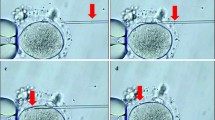Abstract
Sperm characteristics and oocyte quality may play a role in in vitro fertilization. The objective of this paper is to analyze the effect of the quality of oocytes, the husband's semen characteristics, and category of the couple's infertility on the number of spermatozoa bound to the zona pellucida. One hundred eightyone oocytes which failed to fertilize or failed to cleave were fixed in 2.5% glutaraldehyde 40 to 60 hr after insemination in vitro and examined under interference microscopy and the number of sperm bound to the zone pellucida was determined. The means ± SD of sperm bound to mature, immature, and atretic oocytes were 51.0±50.7, 7.3±12.1 10.4±7.8, respectively. Fertilized mature oocytes (81.0±53.3) had a significantly higher number of sperm bound to zonae compared to unfertilized oocytes (41.8±47.3). It is concluded that the number of sperm bound to zonae is functionally important. The sperm motility and the number of motile sperm used to inseminate oocytes were significantly correlated with the number of sperm bound to zonae, whereas sperm morphology and sperm concentration did not correlate. This study supports the notion that sperm motility is the single most important factor influencing fertilization of human oocytes in vitro.
Similar content being viewed by others
References
Edwards RG, Steptoe PC, Purdy JM: Establishing full-term human pregnancies using cleaving embryos grown in vitro. Br J Obstet Gynaecol 1980;87:769–779
Trounson AO, Leeton JF, Wood C, Webb J, Wood J: Successful human pregnancies by in vitro fertilization and embryo transfer in the controlled ovulatory cycle. Science 1981;212:681–682
Mahadevan MM, Trounson AO, Leeton JF: The relationship of tubal blockage infertility of unknown cause, suspectedmale infertility, and endometriosis to success of in vitro fertilization and embryo transfer. Fertil Steril 1983;40:755–762
Wortham JWE Jr, Veeck LL, Witmyer J, Jones HW Jr: Vital initiation of pregnancy (VIP) using menopausal gonadotropin and human chorionic gonadotropin ovulation induction: Phase 1–1981. Fertil Steril 1983;39:785–792
Lopata A, Johnston IWH, Hoult IJ, Spiers AL: Pregnancy following intrauterine implantation of an embryo obtained by in vitro fertilization of a preovulatory egg. Fertil Steril 1980;33:117–120
Trounson AO, Calabrese R: Changes in plasma progesterone concentrations around the time of the LH surge in women superovulated for in vitro fertilization. J Clin Endocrinol Metab 1984;59:1075–1080
Wood C, McMaster R, Rennie G, Trounson AO, Leeton J: Factors influencing pregnancy rates following in vitro fertilization and embryo transfer. Fertil Steril 1985;43:245–250
Nie NH, Hull CH, Jenkins JG, Steinbrenner K, Bent HD: Statistical Package for the Social Sciences. New York, McGraw-Hill, 1975
Gwatkin RBL: Fertilization Mechanisms in Man and Animals. New York, Plenum Press, 1977
Singer SL, Lambert H, Overstreet JW, Hanson FW, Yanagimachi R: The kinetics of human sperm binding to the human zona pellucida and zona-free hamster oocytes in vitro. Gamete Research 1985;72:29–39
Bleil JD, Wassarman PM: Mammalian sperm-egg interaction: Identification of a glycoprotein in mouse egg zonae pellucide possessing receptor activity for sperm. Cell 1980;20:873–882
Fraser LR, Drury ML: The relationship between sperm concentration and fertilization in vitro of mouse eggs. Biol Reprod 1975;13:513–518
Tsunoda Y, Chang MC: Penetration of mouse eggs in vitro: Optimal sperm concentration and minimal number of spermatozoa. J Reprod Fert 1975;44:139–142
Niwa K, Chang M: Optimal sperm concentration and minimal number of spermatozoa for fertilization in vitro of rat eggs. J Reprod Fert 1974;40:471–474
Mahadevan MM, Trounson AO: The influence of seminal characteristics on the success rate of human in vitro fertilization. Fertil Steril 1984;42:400–405
Wolf DP, Inoue M: Sperm concentration dependency in the fertilization and zonal sperm binding properties of mouse eggs inseminated in vitro. J Exp Zool 1976;196:27–38
Aitken RJ, Best FSM, Richardson DW, Djahanbakkch D, Mortimer D, Templeton AA, Lees MM: An analysis of sperm function in cases of unexplained infertility: Conventional criteria, movement characteristics, and fertilizing capacity. Fertil Steril 1982;38:212–221
Ahuja KK, Tzartos SJ: Investigation of sperm receptors in the hamster zona pellucida by using univalent (Fab) antibodies to hamster ovary. J Reprod Fertil 1981;61:257–264
Author information
Authors and Affiliations
Rights and permissions
About this article
Cite this article
Mahadevan, M.M., Trounson, A.O., Wood, C. et al. Effect of oocyte quality and sperm characteristics on the number of spermatozoa bound to the zona pellucida of human oocytes inseminated in vitro. J Assist Reprod Genet 4, 223–227 (1987). https://doi.org/10.1007/BF01533760
Received:
Accepted:
Issue Date:
DOI: https://doi.org/10.1007/BF01533760




